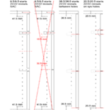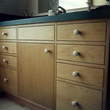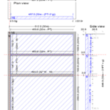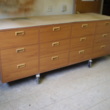Home : 32mm : Styles :
 Railed inset panel heights are always a multiple of 32mm plus two times half the panel thickness (e.g. for 19mm material, 9.5 + 32xn + 9.5, AKA 9.5/9.5 panels and the same height as half-overlay panels). The inset rails need to be the same thickness as the panels and there needs to be a rail between every face. Having a single rail under the top drawer would break the system because the top two faces (drawers or drawer and door) wouldn't center on/between a system hole and their top/bottom edges won't be an equal distance from system holes (red X in the image).
Railed inset panel heights are always a multiple of 32mm plus two times half the panel thickness (e.g. for 19mm material, 9.5 + 32xn + 9.5, AKA 9.5/9.5 panels and the same height as half-overlay panels). The inset rails need to be the same thickness as the panels and there needs to be a rail between every face. Having a single rail under the top drawer would break the system because the top two faces (drawers or drawer and door) wouldn't center on/between a system hole and their top/bottom edges won't be an equal distance from system holes (red X in the image).
Full inset (no rails) panels are always some multiple of 32mm plus gap (split top/bottom) and two times the panel thickness (e.g. for 19mm material and 3mm gaps, 19+1.5 + 32xn + 1.5+19, AKA 20.5/20.5 panels). While it is called a no rail panel, a one increment face can be be used as a rail. Finger pull rails (e.g. Hafele's half moon rail) can also be used.
As with all 32mm panels, all face (drawer, door, etc.) edges (plus 1/2 gap/reveal) can center on or between system holes (one or the other as a constant). Which works best depends on the hardware you use. While drawer slides are typically the determining factor, the Hafele finger-pull-rail mounting brackets are designed to work with face edges that center on system holes (the most common/typical layout).
[ comment | link | top ]
 With the inset style of cabinets the doors/drawers are inset so that their faces are flush with the face of the box. I remember a Fine Homebuilding article on building inset style cabinets using full overlay boxes and what a lot of extra work and pieces it was. Somewhere along the line it occurred to me that the shared panel construction of half-overlay cabinets was ideal for inset cabinets.
With the inset style of cabinets the doors/drawers are inset so that their faces are flush with the face of the box. I remember a Fine Homebuilding article on building inset style cabinets using full overlay boxes and what a lot of extra work and pieces it was. Somewhere along the line it occurred to me that the shared panel construction of half-overlay cabinets was ideal for inset cabinets.
 For the example drawing I simply reduced the perimeter of the half-overlay faces by 11mm so that they would sit inside the openings and have a 3mm reveal. The only other difference is that the system rows have to be moved from 37mm to ~56mm (37 + face thickness) from the front of the box. As with half-overlay, inset panels can be balanced and system holes can be used as construction holes. Both styles will only work (seamless box face) when shared panels are used. When using the 32mm system, half-overlay and inset cabinets are as close as you can get to a 'perfect' cabinet.
For the example drawing I simply reduced the perimeter of the half-overlay faces by 11mm so that they would sit inside the openings and have a 3mm reveal. The only other difference is that the system rows have to be moved from 37mm to ~56mm (37 + face thickness) from the front of the box. As with half-overlay, inset panels can be balanced and system holes can be used as construction holes. Both styles will only work (seamless box face) when shared panels are used. When using the 32mm system, half-overlay and inset cabinets are as close as you can get to a 'perfect' cabinet.
 ...Here's a railed inset (shifted registration) drawing showing how width and height increments work on railed inset base cabinets with undermount drawers. The table has the relevent color coded entries highlighted (use prev/next to switch back and forth).
...Here's a railed inset (shifted registration) drawing showing how width and height increments work on railed inset base cabinets with undermount drawers. The table has the relevent color coded entries highlighted (use prev/next to switch back and forth).
While the full table (34KB pdf) contains information specific to undermount slides (22.5 BO, e.g. Blum and Hettich) and drawer boxes, the carcase and face height/width increments apply to all railed inset cabinets made with 19mm stock and having 3mm face gaps.
See also: Railed Inset Hinge Placement (all the other information on the Increments page is included in the above pdf)
[ comment | link | top ]
 Full inset (no rails) cabinets aren't as perfect/balanced as railed inset. Face heights have to be the standard 32m - g (to line up with system holes) which means the box heights have to be 32m + (2*PT + g) tall. While it is possible to make a single balanced (same height/width) box, more than two vertical panels works much better using railed inset widths (32m + PT boxes and 32m - PT+2*g faces). Using custom widths, face width is opening width - 2*g.
Full inset (no rails) cabinets aren't as perfect/balanced as railed inset. Face heights have to be the standard 32m - g (to line up with system holes) which means the box heights have to be 32m + (2*PT + g) tall. While it is possible to make a single balanced (same height/width) box, more than two vertical panels works much better using railed inset widths (32m + PT boxes and 32m - PT+2*g faces). Using custom widths, face width is opening width - 2*g.
Internal subdivisions (that work so well with HO/RI) don't work here. While I included a split top drawer in the balanced box drawing, it requires 11mm spacers for the outer slides so that the drawer box will center on the drawer face. Internal subdivisions are further complicated because the top and bottom openings are 1/2PT - 1/2g bigger than the rest (FO are 1/2PT smaller, HO/RI openings are all 32m-PT).
 Image is an example of full inset with cabinet width top and bottom panels. The cabinet is two sided with a 19mm inset back running down the center. The top/bottom and ends are full depth, the vertical dividers 1/2 depth - 9.5mm.
Image is an example of full inset with cabinet width top and bottom panels. The cabinet is two sided with a 19mm inset back running down the center. The top/bottom and ends are full depth, the vertical dividers 1/2 depth - 9.5mm.
See also: Increment tables for Box heights, Face Heights and Hinge Hole Placement
[ comment | link | top ]
Inset Flush
Shared panel inset boxes can be made with rails between every drawer and door face (railed-inset) or with no rails between the faces. In the later (no-rail-inset) case, a single increment face can be a rail.
See also: Inset-Flush Half-Overlay

See also: Inset-Flush Half-Overlay
Inset Panel Heights
 Railed inset panel heights are always a multiple of 32mm plus two times half the panel thickness (e.g. for 19mm material, 9.5 + 32xn + 9.5, AKA 9.5/9.5 panels and the same height as half-overlay panels). The inset rails need to be the same thickness as the panels and there needs to be a rail between every face. Having a single rail under the top drawer would break the system because the top two faces (drawers or drawer and door) wouldn't center on/between a system hole and their top/bottom edges won't be an equal distance from system holes (red X in the image).
Railed inset panel heights are always a multiple of 32mm plus two times half the panel thickness (e.g. for 19mm material, 9.5 + 32xn + 9.5, AKA 9.5/9.5 panels and the same height as half-overlay panels). The inset rails need to be the same thickness as the panels and there needs to be a rail between every face. Having a single rail under the top drawer would break the system because the top two faces (drawers or drawer and door) wouldn't center on/between a system hole and their top/bottom edges won't be an equal distance from system holes (red X in the image). Full inset (no rails) panels are always some multiple of 32mm plus gap (split top/bottom) and two times the panel thickness (e.g. for 19mm material and 3mm gaps, 19+1.5 + 32xn + 1.5+19, AKA 20.5/20.5 panels). While it is called a no rail panel, a one increment face can be be used as a rail. Finger pull rails (e.g. Hafele's half moon rail) can also be used.
As with all 32mm panels, all face (drawer, door, etc.) edges (plus 1/2 gap/reveal) can center on or between system holes (one or the other as a constant). Which works best depends on the hardware you use. While drawer slides are typically the determining factor, the Hafele finger-pull-rail mounting brackets are designed to work with face edges that center on system holes (the most common/typical layout).
[ comment | link | top ]
Railed Inset
 With the inset style of cabinets the doors/drawers are inset so that their faces are flush with the face of the box. I remember a Fine Homebuilding article on building inset style cabinets using full overlay boxes and what a lot of extra work and pieces it was. Somewhere along the line it occurred to me that the shared panel construction of half-overlay cabinets was ideal for inset cabinets.
With the inset style of cabinets the doors/drawers are inset so that their faces are flush with the face of the box. I remember a Fine Homebuilding article on building inset style cabinets using full overlay boxes and what a lot of extra work and pieces it was. Somewhere along the line it occurred to me that the shared panel construction of half-overlay cabinets was ideal for inset cabinets.  For the example drawing I simply reduced the perimeter of the half-overlay faces by 11mm so that they would sit inside the openings and have a 3mm reveal. The only other difference is that the system rows have to be moved from 37mm to ~56mm (37 + face thickness) from the front of the box. As with half-overlay, inset panels can be balanced and system holes can be used as construction holes. Both styles will only work (seamless box face) when shared panels are used. When using the 32mm system, half-overlay and inset cabinets are as close as you can get to a 'perfect' cabinet.
For the example drawing I simply reduced the perimeter of the half-overlay faces by 11mm so that they would sit inside the openings and have a 3mm reveal. The only other difference is that the system rows have to be moved from 37mm to ~56mm (37 + face thickness) from the front of the box. As with half-overlay, inset panels can be balanced and system holes can be used as construction holes. Both styles will only work (seamless box face) when shared panels are used. When using the 32mm system, half-overlay and inset cabinets are as close as you can get to a 'perfect' cabinet. ...Here's a railed inset (shifted registration) drawing showing how width and height increments work on railed inset base cabinets with undermount drawers. The table has the relevent color coded entries highlighted (use prev/next to switch back and forth).
...Here's a railed inset (shifted registration) drawing showing how width and height increments work on railed inset base cabinets with undermount drawers. The table has the relevent color coded entries highlighted (use prev/next to switch back and forth). While the full table (34KB pdf) contains information specific to undermount slides (22.5 BO, e.g. Blum and Hettich) and drawer boxes, the carcase and face height/width increments apply to all railed inset cabinets made with 19mm stock and having 3mm face gaps.
See also: Railed Inset Hinge Placement (all the other information on the Increments page is included in the above pdf)
[ comment | link | top ]
Full Inset
 Full inset (no rails) cabinets aren't as perfect/balanced as railed inset. Face heights have to be the standard 32m - g (to line up with system holes) which means the box heights have to be 32m + (2*PT + g) tall. While it is possible to make a single balanced (same height/width) box, more than two vertical panels works much better using railed inset widths (32m + PT boxes and 32m - PT+2*g faces). Using custom widths, face width is opening width - 2*g.
Full inset (no rails) cabinets aren't as perfect/balanced as railed inset. Face heights have to be the standard 32m - g (to line up with system holes) which means the box heights have to be 32m + (2*PT + g) tall. While it is possible to make a single balanced (same height/width) box, more than two vertical panels works much better using railed inset widths (32m + PT boxes and 32m - PT+2*g faces). Using custom widths, face width is opening width - 2*g.Internal subdivisions (that work so well with HO/RI) don't work here. While I included a split top drawer in the balanced box drawing, it requires 11mm spacers for the outer slides so that the drawer box will center on the drawer face. Internal subdivisions are further complicated because the top and bottom openings are 1/2PT - 1/2g bigger than the rest (FO are 1/2PT smaller, HO/RI openings are all 32m-PT).
 Image is an example of full inset with cabinet width top and bottom panels. The cabinet is two sided with a 19mm inset back running down the center. The top/bottom and ends are full depth, the vertical dividers 1/2 depth - 9.5mm.
Image is an example of full inset with cabinet width top and bottom panels. The cabinet is two sided with a 19mm inset back running down the center. The top/bottom and ends are full depth, the vertical dividers 1/2 depth - 9.5mm. See also: Increment tables for Box heights, Face Heights and Hinge Hole Placement
[ comment | link | top ]
